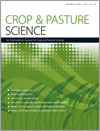
Crop and Pasture Science
Volume 64 Number 7 2013
CP13076Use of productivity-defined indicators to assess exposure of grassland-based livestock systems to climate change and variability
CP13103Interspecific introgression of male sterility from tetraploid oilseed Brassica napus to diploid vegetable B. rapa through hybridisation and backcrossing
The most widely used approach for Purple Cai-Tai (Brassica rapa) production is based on hybrid seeds which requires cytoplasmic male sterile plants. The lack of stable cytoplasmic male sterility in B. rapa background, makes hybrid seed production process less efficient. In this study, we were able to transfer the newly developed stable cytoplasmic male sterility from canola into Purple Cai-Tai which could facilitate an efficient system for hybrid seed production.
CP13178Leaf growth and senescence rates of three pasture grasses and wheat
Information to calibrate the senescence (plant death) algorithms of plant growth models in agricultural decision support tools is often not readily available. This study comprehensively measured the leaf growth characteristics and developed statistical models for leaf turnover rates of four common grasses. Decision support tools which incorporate robust senescence algorithms may then be applied to simulation studies which assess grass curing (percentage of dead material in the sward) for planning activities such as resource allocation, wildfire suppression, and execution of prescribed burning programs by fire management agencies.
CP13003Summer-active perennials in pasture systems improve seasonal pasture distribution without compromising winter-spring production
Livestock production in high rainfall southern Australia is limited by perennial ryegrass pastures that only grow for 8-9 months of the year and don’t respond to summer rainfall. Careful matching of summer-active pastures such as lucerne, tall fescue and chicory to suitable soil types allows feed to grow throughout the year. This gives increased animal production potential generally and increased flexibility in tough times because of a more diverse mix of pasture types.
CP13066Morphology and Rubisco turnover characteristics of perennial ryegrass breeding populations after two and four cycles of divergent selection for long or short leaf length
Ryegrass leaves use Rubisco enzyme to capture CO2 from the air and manufacture food. Rubisco contains about 25% nitrogen. When the leaf dies, Rubisco breaks down and its nitrogen is recycled and used by other growing plant parts. This research investigated how different ryegrass plant types utilise nitrogen in Rubisco to fulfil the two roles. The key finding is that plants that make less Rubisco are more economical and can be used in a grass improvement programme aimed at reducing fertiliser nitrogen usage.
CP13161Photosynthetic impairment caused by manganese toxicity and associated antioxidative responses in perennial ryegrass
The photosynthetic performance and the antioxidant responses in two perennial ryegrass cultivars were characterized. The importance of non-enzymatic antioxidants such as phenolic compounds in forage palatability had increased. Enzymatic and non-enzymatic antioxidant responses were increased in response to Mn excess but mainly in the Mn-tolerant cv. Kingston, which showed lower photosynthesis impairments compared to the Mn-sensitive cv. Nui. Phenolics concentrations and composition were significantly affected by Mn concentration in perennial ryegrass, which can be important in improving the quality of animal feed.
CP13211Herbicide efficacy for control of annual ryegrass (Lolium rigidum Gaud.) is influenced more by wheat seeding rate than row spacing
Conservation cropping systems with no-till and stubble retention improve soil health and water availability but crops are often less competitive with weeds and are more dependent on herbicides. Increasing wheat seeding rate is a relatively simple, low-cost option for enhancing wheat competitiveness against weeds and improving herbicide performance. This technique will become more important in the future as herbicide resistance spreads and herbicide efficacy is reduced with the trend to hotter and drier conditions associated with climate change.
CP13067Characterisation of novel perennial ryegrass host–Neotyphodium endophyte associations
Temperate pasture grasses such as perennial ryegrass form mutually beneficial associations with fungal endophytes. Levels of endophyte colonisation, production of anti-invertebrate and anti-mammalian alkaloids, and various morphological characteristics were determined for a range of host grass – novel endophyte combinations. Evidence that differences in both host and endophyte performance contribute to agronomic performance was obtained, providing the basis for more precise matching in future grass breeding programs.
CP13064Interactions between waterlogging and ray blight in pyrethrum
Australia is the world’s leading producer of pyrethrum. The major abiotic and biotic stresses of pyrethrum are waterlogging and ray blight disease, respectively. This study quantified the potential for synergistic interactions between these stresses. Results suggested that pyrethrum plants recovered slowly following waterlogging but suffered irreversible damage when both stresses were imposed simultaneously. Findings of this study will help selection and breeding for tolerance to these common, but previously poorly understood, stress interactions in pyrethrum.



